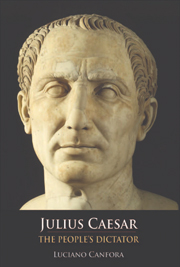Book contents
- Frontmatter
- Contents
- Translators' Note
- Acknowledgements
- Foreword
- PART I FROM SULLA TO CATILINE
- PART II FROM THE TRIUMVIRATE TO THE CONQUEST OF GAUL
- PART III THE LONG CIVIL WAR
- 16 Towards the Crisis
- 17 Striving after Tyranny?
- 18 Attacking the World with Five Cohorts
- 19 Caesar's ‘Programme’: In Search of Consensus
- 20 ‘Amicitia’
- 21 From the Rubicon to Pharsalus
- 22 Against Subversion
- 23 Alexandria
- 24 Caesar Saved by the Jews
- 25 From Syria to Zela
- 26 The Long Civil War
- 27 The Shoot of a Palm Tree: The Young Octavius Emerges
- 28 ‘Anticato’
- PART IV FROM THE CONSPIRACY TO THE TRIUMPH OF CAESARISM
- Chronology
- Bibliography
- Index
16 - Towards the Crisis
from PART III - THE LONG CIVIL WAR
Published online by Cambridge University Press: 05 August 2013
- Frontmatter
- Contents
- Translators' Note
- Acknowledgements
- Foreword
- PART I FROM SULLA TO CATILINE
- PART II FROM THE TRIUMVIRATE TO THE CONQUEST OF GAUL
- PART III THE LONG CIVIL WAR
- 16 Towards the Crisis
- 17 Striving after Tyranny?
- 18 Attacking the World with Five Cohorts
- 19 Caesar's ‘Programme’: In Search of Consensus
- 20 ‘Amicitia’
- 21 From the Rubicon to Pharsalus
- 22 Against Subversion
- 23 Alexandria
- 24 Caesar Saved by the Jews
- 25 From Syria to Zela
- 26 The Long Civil War
- 27 The Shoot of a Palm Tree: The Young Octavius Emerges
- 28 ‘Anticato’
- PART IV FROM THE CONSPIRACY TO THE TRIUMPH OF CAESARISM
- Chronology
- Bibliography
- Index
Summary
Without doubt the most dangerous moment for Caesar in the political crisis which erupted in Rome, while he was occupied with the revolt of Vercingetorix, was the designation of Pompey as ‘consul without colleague’ (consul sine collega) at the end of February 52 bc. This happened in a most traumatic way from the point of view of the triumvirate (which had been strengthened at Luca but ‘decapitated’ by the death of Crassus at Carrhae, in Syria, in the catastrophic campaign against the Parthians). The destructive and uncontrollable street fighting which led to the assassination of Clodius at Bovillae (18 January 52) was diametrically opposed to Caesar's interests. It was not in his interest to appear as the instigator of a subversive faction such as Clodius', nor was it in his interest that the deleterious activities of that faction should push Pompey to seek the backing of the factio (and vice versa). What most conflicted with his intention never to break with Pompey was the street fighting: it could lead to a state of emergency (senatus consultum ultimum), with effective power in the hands of the proconsul stationed at the gates of Rome – Pompey. And this is precisely what happened, precipitated by the murder of Clodius. The Senate resorted to emergency powers and charged Pompey himself (‘qui pro consule ad urbem erat’, as the senatus consultum said), together with the tribunes of the plebs and the interrex, with ‘assuring the salvation of the republic’.
- Type
- Chapter
- Information
- Julius CaesarThe People's Dictator, pp. 127 - 136Publisher: Edinburgh University PressPrint publication year: 2007



